外研版(2019) 必修第一册 Unit 6 At one with nature Understanding ideas PPT(共30张)
文档属性
| 名称 | 外研版(2019) 必修第一册 Unit 6 At one with nature Understanding ideas PPT(共30张) |  | |
| 格式 | ppt | ||
| 文件大小 | 14.2MB | ||
| 资源类型 | 教案 | ||
| 版本资源 | 外研版(2019) | ||
| 科目 | 英语 | ||
| 更新时间 | 2022-08-03 20:20:16 | ||
图片预览

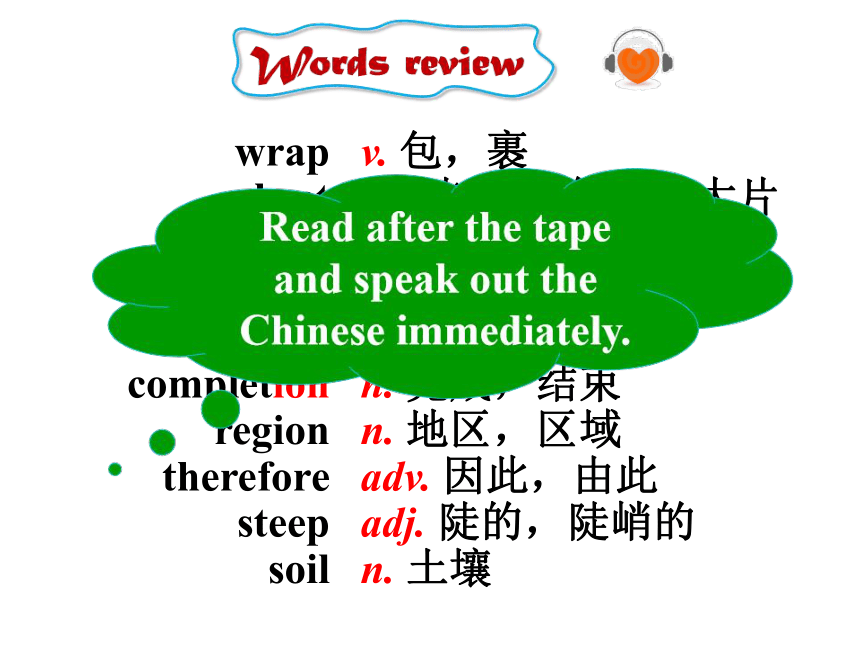



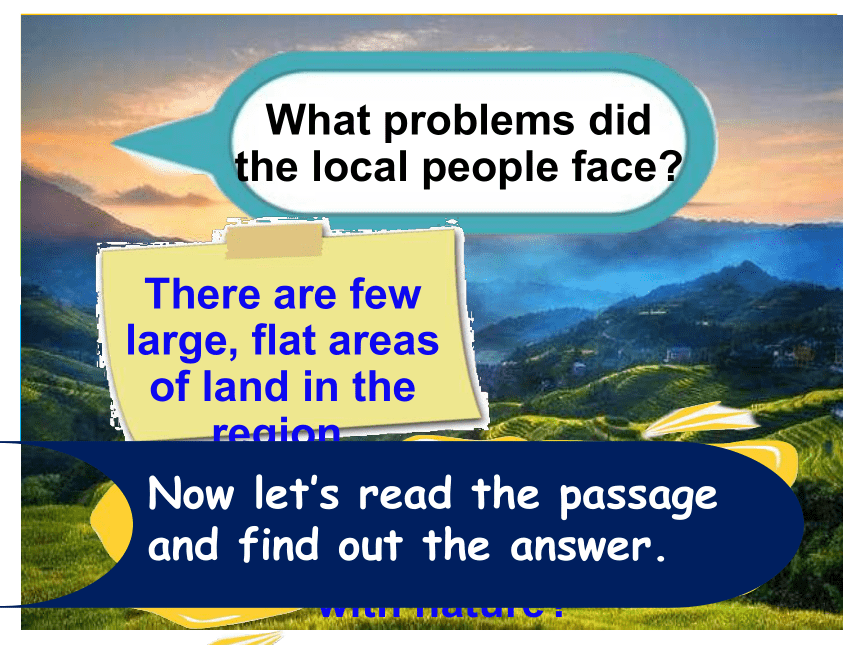


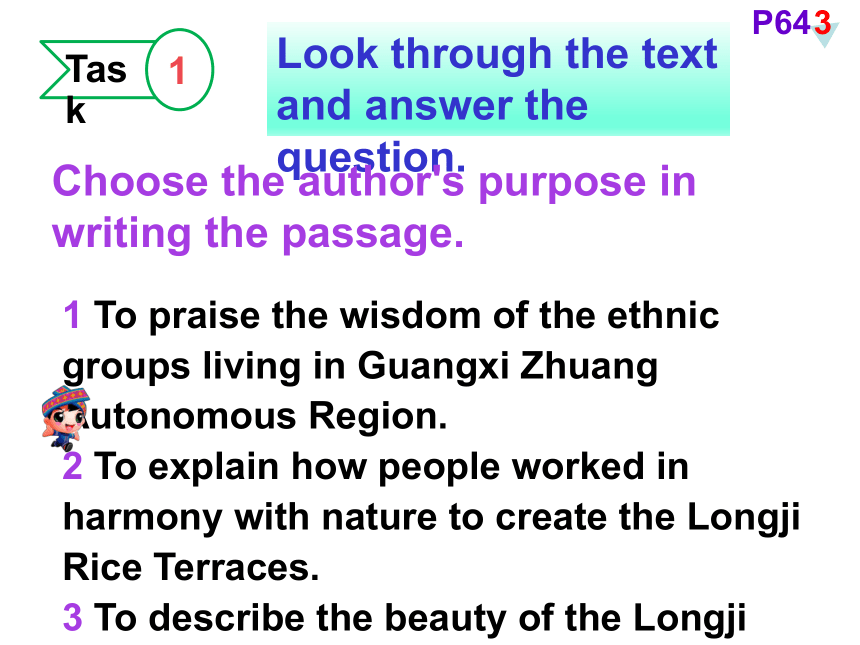
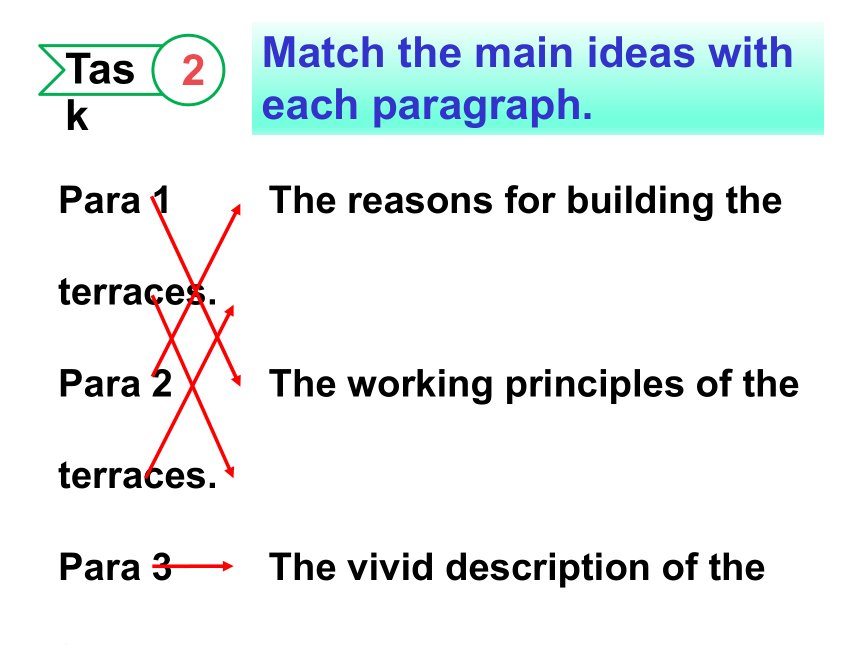

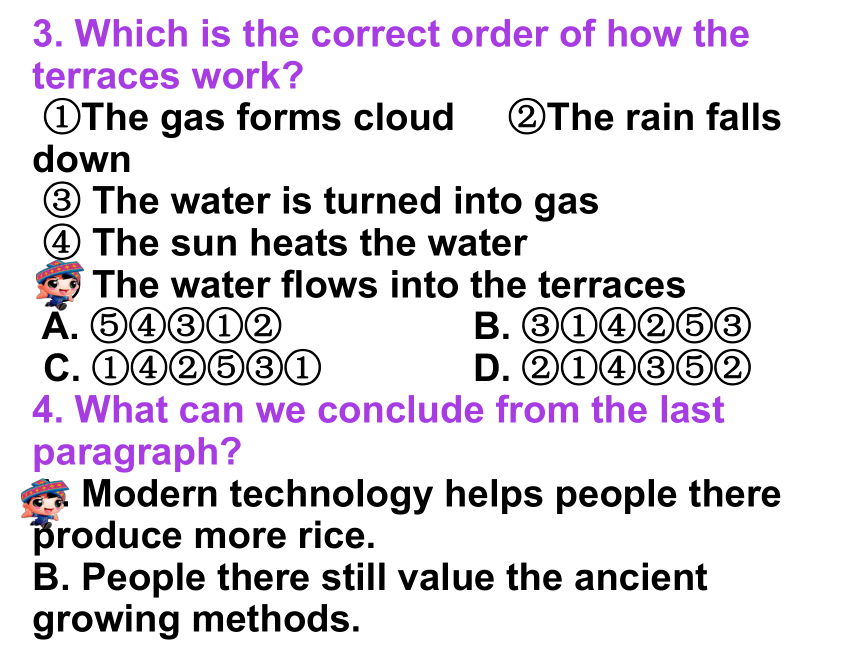
文档简介
(共30张PPT)
At one with nature
Unit 6
P2
Understanding ideas
wrap
sheet
frost
terrace
dynasty
completion
region
therefore
steep
soil
v. 包,裹
n. (冰或水等的)一大片
n. 霜
n. 梯田
n. 朝代
n. 完成,结束
n. 地区,区域
adv. 因此,由此
adj. 陡的,陡峭的
n. 土壤
shallow
prevent
harmony
design
vapour
harm
crop
agriculture
adj. 浅的
v. 阻挡,防止
n. 融洽相处,和谐
v. 设计
n. 蒸气
v. 伤害,损害
n. 庄稼,作物
n. 农业
Before reading
Look at the pictures and talk about what
you know about the Zhuang and Yao ethnic.
*You can experience China's ethnic minorities' culture (such as,The Zhuang brocade(壮族织锦), Zhuang New Year and the Zhuang architecture,etc.) there.
*People there dress in unique and colorful costumes, singing and dancing.
*Zhuang ethnic minority is the largest minority group of China. Over 90% of the Zhuang people live in Guangxi Zhuang Autonomous Region(广西壮族自治区).
*The Yao, densely concentrated in some mountain districts, are an another ethnic minority in Guangxi.
What problems did the local people face
How did the local people solve the problem by working with nature
There are few large, flat areas of land in the region.
Now let’s read the passage and find out the answer.
Here are some photos of Longji Rice Terraces. Now let's enjoy them.
They built the Longji Rice Terraces.
While reading
Read and finish the tasks as quickly as possible.
Task
1
Look through the text and answer the question.
Choose the author's purpose in writing the passage.
1 To praise the wisdom of the ethnic groups living in Guangxi Zhuang Autonomous Region.
2 To explain how people worked in harmony with nature to create the Longji Rice Terraces.
3 To describe the beauty of the Longji Rice Terraces and to attract visitors to this scenic spot.
3
P64
Task
2
Match the main ideas with each paragraph.
Para 1 The reasons for building the terraces.
Para 2 The working principles of the terraces.
Para 3 The vivid description of the terraces.
Para 4 The history of the terraces.
Para 5 Its meaning to local people.
Task
3
Choose the best answer according to the passage.
1. How does the author develop Paragraph 1
A. By listing the facts.
B. By comparing the facts.
C. By vividly descripting the scene.
D. By painting the beautiful colors
2. Which is not the reason why the people built
the terraces
A. Lack of enough flat areas
B. Holding the rainwater
C. Protecting the soil
D. Making the mountains more steep
3. Which is the correct order of how the terraces work
①The gas forms cloud ②The rain falls down
③ The water is turned into gas
④ The sun heats the water
⑤ The water flows into the terraces
A. ⑤④③①② B. ③①④②⑤③
C. ①④②⑤③① D. ②①④③⑤②
4. What can we conclude from the last paragraph
A. Modern technology helps people there produce more rice.
B. People there still value the ancient growing methods.
C. Many visitors come here to learn how to grow rice.
D.The young people there like to create great wonders.
Rainwater
waterways
Clouds
vapour
Read the passage again and find out the working principle of the Longji Rice Terraces.
5
P64
Task
4
During the rainy season, rainwater moves down the mountains along hundreds of waterways that connect with each other and the terraces. The sun heats the water and turns it into vapour. This forms clouds from which rain falls down onto the mountain terraces once again.
One possible answer
Task
5
Read the summary of the passage and correct four factual mistakes.
The Longji Rice Terraces were built by the local Zhuang ethnic group alone. Though there are many large, flat areas in the region, they built terraces on the mountains to have more areas to grow rice. The terraces are cleverly designed, and can wash away the shallow soil. There are hundreds of waterways, along which rainwater moves down the mountains and into the terraces. Today, local people use modern methods to maintain the terraces, and they attract lots of visitors from all over the country.
by the local
Zhuang and Yao people
Since
few
hold
ancient
methods of
agriculture
4
P64
After reading
analyzing, further learning and summary
1. Reaching as far as the eye can see, these terraces cover tall mountains, often from the bottom to the very top.
现在分词短语做状语
eg.①Turning to the left, you will find the school.
向左拐,你就会发现那所学校。
②Knowing where I live, he never comes to see me.
尽管知道我住哪儿,但他从不来看我。
as far as
①As far as the eye can see, the wave are to be seen rolling in all directions.
目之所及,到处浪涛滚滚。
②As far as I know, compared with other countries, Chinese students spend much more time studying.
据我所知,与其他国家相比较,中国学生花费更多的时间来学习。
就……来说,在……范围内
做状语
Paraphrase
These terraces stretch all the way to the very far end of our vision, and often range from the bottom to the very top of tall mountains.
目之所及, 梯田包裹着巍峨的高山,往往从山脚一直盘绕到山顶。
Sentence analyzing for better understanding
1
2. During the rainy season, it is along these
waterways that rainwater moves down the
mountains and into the terraces.
it is
along these
waterways
that
主语
宾语
状语
强调人用
that/who,强
调物用that
It is/was
被强调部分
that/who+ 句子其余部分
+
+
eg.①It was Tom that/who broke the window.
就是汤姆打破了窗户。
②It is because he is ill that he can’t come.
正是因为他病了,所以他不能来。
在雨季,雨水会沿着这些水渠从山上流下进入梯田。
翻译句子。
1. As far as I'm concerned, not only does outdoor exercise get us close to nature
but also give us relaxation from heavy schoolwork.
就我个人而言,户外运动不仅使我们接近大自然,而且使我们从沉重的学习任务中摆脱出来得以休息。
2. 他第一次遇见他的妻子是在公园里。
It was in the park that he met his wife for the first time.
1. Pass down the knowledge through families.
2. It’s a great wonder created by people and nature working together.
5. Its value
1. Its scenery
2. The history
3. The reasons
4. Its working principle
Longji Rice Terraces
spring-summer-autumn-winter
Who: Zhuang and Yao people
When: in the Yuan Dynasty
1 few large, flat areas of land
2 steep mountains and shallow soil→ was washed away
rainwater-waterways-vapour-clouds-rainwater…
Try to retell the passage Longji Rice Terraces.
2
Longji Rice Terraces
Discussion
Think & Share.
Why do the local people still keep their traditional way of growing rice
In what other ways do people live in harmony with nature Give examples.
Possible answers
1. Because the knowledge is passed down through generations of families, and it suits the natural environment.
2.*Cave dwellings in north-west China
*Bamboo house of Dai people
...
Conclusion
What have you learned from the passage
Discuss with your partners.
※ Our ancestors accumulate a lot of experience on how to adapt to the local environment, from whom we can learn a lot.
※ We should learn to live in harmony with nature.
I. Match the words with their definitions.
1. The dry rocky __________ is unsuitable for planting apple trees.
2. After the heavy rains the fields were covered with a __________ of water.
3. The Golden Gate Bridge was __________ by Joseph Strauss.
4. We woke up to see the bushes covered with a layer of white __________.
5. The new law was passed to promote social and racial __________ between the different groups of people living there.
6. This is one of the poorest __________ in the country.
7. He __________ up the presents carefully and placed them under the Christmas tree.
sheet wrap frost
region soil harmony design
sheet
designed
frost
harmony
soil
region
wrapped
plete the sentences with the correct form of the words in the box.
1. Can you describe the background, the reasons for building the terraces and the working principle of Longji Rice Terraces
2. How do people adapt to the local environment and live in harmony with nature
Self-evaluation
各个击破
Polish your summary of this passage.
At one with nature
Unit 6
P2
Understanding ideas
wrap
sheet
frost
terrace
dynasty
completion
region
therefore
steep
soil
v. 包,裹
n. (冰或水等的)一大片
n. 霜
n. 梯田
n. 朝代
n. 完成,结束
n. 地区,区域
adv. 因此,由此
adj. 陡的,陡峭的
n. 土壤
shallow
prevent
harmony
design
vapour
harm
crop
agriculture
adj. 浅的
v. 阻挡,防止
n. 融洽相处,和谐
v. 设计
n. 蒸气
v. 伤害,损害
n. 庄稼,作物
n. 农业
Before reading
Look at the pictures and talk about what
you know about the Zhuang and Yao ethnic.
*You can experience China's ethnic minorities' culture (such as,The Zhuang brocade(壮族织锦), Zhuang New Year and the Zhuang architecture,etc.) there.
*People there dress in unique and colorful costumes, singing and dancing.
*Zhuang ethnic minority is the largest minority group of China. Over 90% of the Zhuang people live in Guangxi Zhuang Autonomous Region(广西壮族自治区).
*The Yao, densely concentrated in some mountain districts, are an another ethnic minority in Guangxi.
What problems did the local people face
How did the local people solve the problem by working with nature
There are few large, flat areas of land in the region.
Now let’s read the passage and find out the answer.
Here are some photos of Longji Rice Terraces. Now let's enjoy them.
They built the Longji Rice Terraces.
While reading
Read and finish the tasks as quickly as possible.
Task
1
Look through the text and answer the question.
Choose the author's purpose in writing the passage.
1 To praise the wisdom of the ethnic groups living in Guangxi Zhuang Autonomous Region.
2 To explain how people worked in harmony with nature to create the Longji Rice Terraces.
3 To describe the beauty of the Longji Rice Terraces and to attract visitors to this scenic spot.
3
P64
Task
2
Match the main ideas with each paragraph.
Para 1 The reasons for building the terraces.
Para 2 The working principles of the terraces.
Para 3 The vivid description of the terraces.
Para 4 The history of the terraces.
Para 5 Its meaning to local people.
Task
3
Choose the best answer according to the passage.
1. How does the author develop Paragraph 1
A. By listing the facts.
B. By comparing the facts.
C. By vividly descripting the scene.
D. By painting the beautiful colors
2. Which is not the reason why the people built
the terraces
A. Lack of enough flat areas
B. Holding the rainwater
C. Protecting the soil
D. Making the mountains more steep
3. Which is the correct order of how the terraces work
①The gas forms cloud ②The rain falls down
③ The water is turned into gas
④ The sun heats the water
⑤ The water flows into the terraces
A. ⑤④③①② B. ③①④②⑤③
C. ①④②⑤③① D. ②①④③⑤②
4. What can we conclude from the last paragraph
A. Modern technology helps people there produce more rice.
B. People there still value the ancient growing methods.
C. Many visitors come here to learn how to grow rice.
D.The young people there like to create great wonders.
Rainwater
waterways
Clouds
vapour
Read the passage again and find out the working principle of the Longji Rice Terraces.
5
P64
Task
4
During the rainy season, rainwater moves down the mountains along hundreds of waterways that connect with each other and the terraces. The sun heats the water and turns it into vapour. This forms clouds from which rain falls down onto the mountain terraces once again.
One possible answer
Task
5
Read the summary of the passage and correct four factual mistakes.
The Longji Rice Terraces were built by the local Zhuang ethnic group alone. Though there are many large, flat areas in the region, they built terraces on the mountains to have more areas to grow rice. The terraces are cleverly designed, and can wash away the shallow soil. There are hundreds of waterways, along which rainwater moves down the mountains and into the terraces. Today, local people use modern methods to maintain the terraces, and they attract lots of visitors from all over the country.
by the local
Zhuang and Yao people
Since
few
hold
ancient
methods of
agriculture
4
P64
After reading
analyzing, further learning and summary
1. Reaching as far as the eye can see, these terraces cover tall mountains, often from the bottom to the very top.
现在分词短语做状语
eg.①Turning to the left, you will find the school.
向左拐,你就会发现那所学校。
②Knowing where I live, he never comes to see me.
尽管知道我住哪儿,但他从不来看我。
as far as
①As far as the eye can see, the wave are to be seen rolling in all directions.
目之所及,到处浪涛滚滚。
②As far as I know, compared with other countries, Chinese students spend much more time studying.
据我所知,与其他国家相比较,中国学生花费更多的时间来学习。
就……来说,在……范围内
做状语
Paraphrase
These terraces stretch all the way to the very far end of our vision, and often range from the bottom to the very top of tall mountains.
目之所及, 梯田包裹着巍峨的高山,往往从山脚一直盘绕到山顶。
Sentence analyzing for better understanding
1
2. During the rainy season, it is along these
waterways that rainwater moves down the
mountains and into the terraces.
it is
along these
waterways
that
主语
宾语
状语
强调人用
that/who,强
调物用that
It is/was
被强调部分
that/who+ 句子其余部分
+
+
eg.①It was Tom that/who broke the window.
就是汤姆打破了窗户。
②It is because he is ill that he can’t come.
正是因为他病了,所以他不能来。
在雨季,雨水会沿着这些水渠从山上流下进入梯田。
翻译句子。
1. As far as I'm concerned, not only does outdoor exercise get us close to nature
but also give us relaxation from heavy schoolwork.
就我个人而言,户外运动不仅使我们接近大自然,而且使我们从沉重的学习任务中摆脱出来得以休息。
2. 他第一次遇见他的妻子是在公园里。
It was in the park that he met his wife for the first time.
1. Pass down the knowledge through families.
2. It’s a great wonder created by people and nature working together.
5. Its value
1. Its scenery
2. The history
3. The reasons
4. Its working principle
Longji Rice Terraces
spring-summer-autumn-winter
Who: Zhuang and Yao people
When: in the Yuan Dynasty
1 few large, flat areas of land
2 steep mountains and shallow soil→ was washed away
rainwater-waterways-vapour-clouds-rainwater…
Try to retell the passage Longji Rice Terraces.
2
Longji Rice Terraces
Discussion
Think & Share.
Why do the local people still keep their traditional way of growing rice
In what other ways do people live in harmony with nature Give examples.
Possible answers
1. Because the knowledge is passed down through generations of families, and it suits the natural environment.
2.*Cave dwellings in north-west China
*Bamboo house of Dai people
...
Conclusion
What have you learned from the passage
Discuss with your partners.
※ Our ancestors accumulate a lot of experience on how to adapt to the local environment, from whom we can learn a lot.
※ We should learn to live in harmony with nature.
I. Match the words with their definitions.
1. The dry rocky __________ is unsuitable for planting apple trees.
2. After the heavy rains the fields were covered with a __________ of water.
3. The Golden Gate Bridge was __________ by Joseph Strauss.
4. We woke up to see the bushes covered with a layer of white __________.
5. The new law was passed to promote social and racial __________ between the different groups of people living there.
6. This is one of the poorest __________ in the country.
7. He __________ up the presents carefully and placed them under the Christmas tree.
sheet wrap frost
region soil harmony design
sheet
designed
frost
harmony
soil
region
wrapped
plete the sentences with the correct form of the words in the box.
1. Can you describe the background, the reasons for building the terraces and the working principle of Longji Rice Terraces
2. How do people adapt to the local environment and live in harmony with nature
Self-evaluation
各个击破
Polish your summary of this passage.
